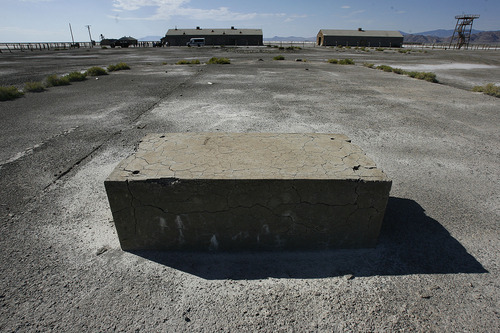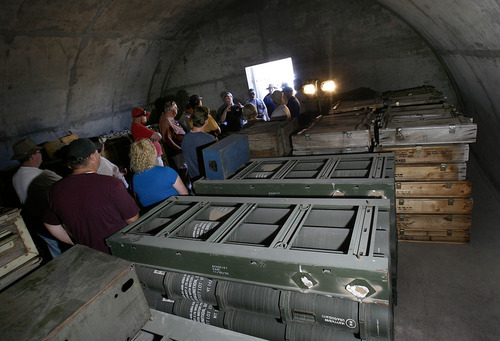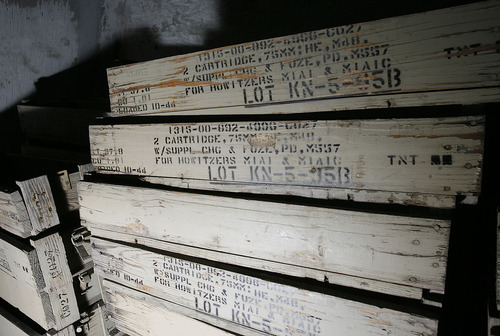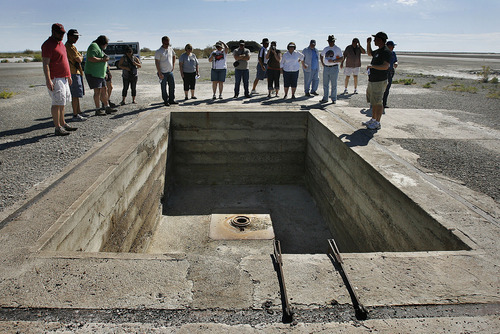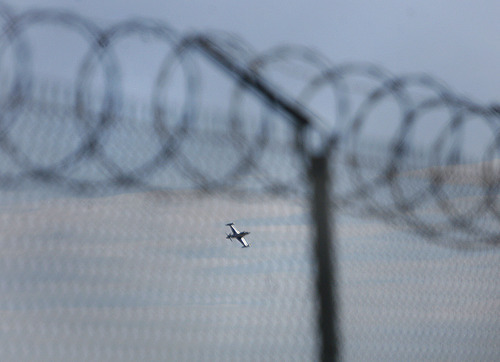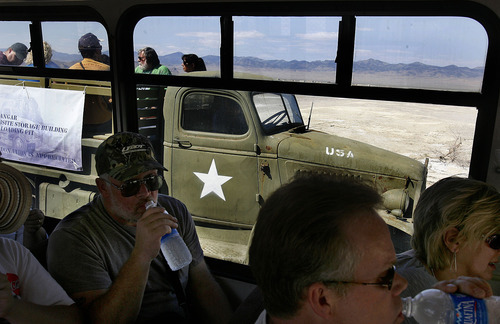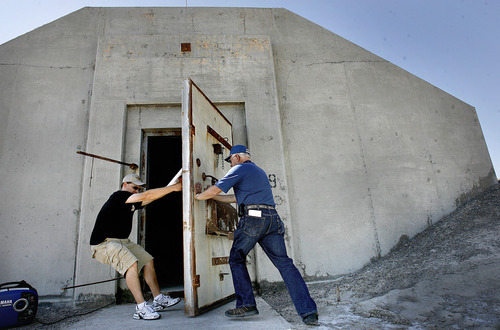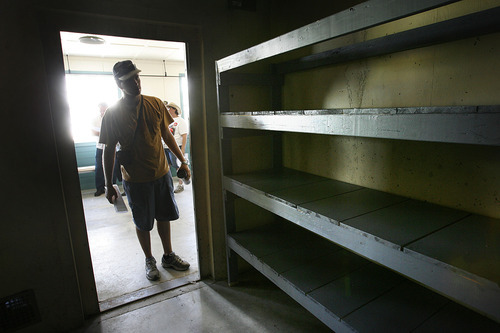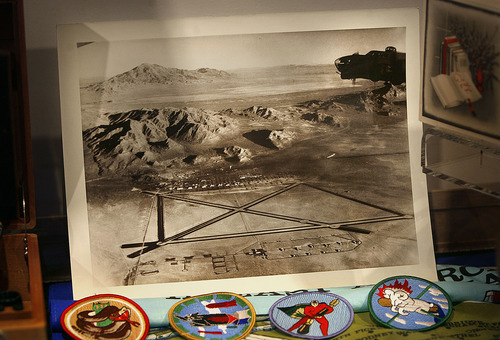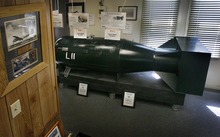Scott Sommerdorf | The Salt Lake Tribune
Tour guide Tom Petersen stands in a vintage jeep to describe the previously secret Worl
Scott Sommerdorf | The Salt Lake Tribune
The concrete slab where components of the bombs that preceeded Little Boy and Fat Man w
Scott Sommerdorf | The Salt Lake Tribune
The inside of Bomb Storage Bunker 49. The Wendover Airfield Museum gave a tour of the s
Scott Sommerdorf | The Salt Lake Tribune
The Wendover Airfield Museum gave a tour of the secret World War II base facilities whi
Scott Sommerdorf | The Salt Lake Tribune
Boxes that used to hold howitzer shells are stacked up inside Bomb Storage Bunker 49. T
Scott Sommerdorf | The Salt Lake Tribune
Tour guide Tom Petersen (right) explains the history behind what he called "the most im
Scott Sommerdorf | The Salt Lake Tribune
A T-33 trainer flies by one of the secret facilities at the Wendover Airfield which h
Scott Sommerdorf | The Salt Lake Tribune
People were taken on a tour of the secret Wendover Airfield World War II base facilitie
Scott Sommerdorf | The Salt Lake Tribune
Tour guides Tom (left) and Jim Petersen open up Bomb Storage Bunker 49 to a tour for th
Scott Sommerdorf | The Salt Lake Tribune
Tour guide Tom Petersen introduces the tour to the now-open building where the highly s
Scott Sommerdorf | The Salt Lake Tribune
A T-33 trainer taxis past what museum tourguides called "the most important hole in the
Scott Sommerdorf | The Salt Lake Tribune
The Wendover Airfield Museum gave a tour of the secret World War II base facilities whi
Scott Sommerdorf | The Salt Lake Tribune
A visitor peers into the now-unsealed room where the highly secret Norden bomb sights w
Scott Sommerdorf | The Salt Lake Tribune
An old photo showing a B-17 flying over Wendover Airfield is on display at the Wendover
Scott Sommerdorf | The Salt Lake Tribune
A replica of the Little Boy atomic boms is on display at the Wendover Airfield Museum.
Scott Sommerdorf | The Salt Lake Tribune
Tour guide Tom Petersen stands in a vintage jeep to describe the previously secret World War II base facilities which have never been offered on a tour before. The tour included rarely open buildings and areas such as: Atomic bomb loading pit Atomic bomb assembly buildings Bomb Storage Bunkers Enlisted Mess hall Aircraft hangars Fire station Enlisted Barracks Norden Bombsight building Officers Mess hall B-29 Enola Gay hangar, Saturday, August 26, 2011.
Scott Sommerdorf | The Salt Lake Tribune
The concrete slab where components of the bombs that preceeded Little Boy and Fat Man was one of the attractions on a tour of the secret facilities at Wendover Airfield, Saturday, August 26, 2011. The tour has never been offered before. It included rarely open buildings and areas such as: Atomic bomb loading pit Atomic bomb assembly buildings Bomb Storage Bunkers Enlisted Mess hall Aircraft hangars Fire station Enlisted Barracks Norden Bombsight building Officers Mess hall B-29 Enola Gay hangar.
Scott Sommerdorf | The Salt Lake Tribune
The inside of Bomb Storage Bunker 49. The Wendover Airfield Museum gave a tour of the secret World War II base facilities which has never been offered before. The tour included rarely open buildings and areas such as: Atomic bomb loading pit Atomic bomb assembly buildings Bomb Storage Bunkers Enlisted Mess hall Aircraft hangars Fire station Enlisted Barracks Norden Bombsight building Officers Mess hall B-29 Enola Gay hangar, Saturday, August 26, 2011.
Scott Sommerdorf | The Salt Lake Tribune
The Wendover Airfield Museum gave a tour of the secret World War II base facilities which has never been offered before. The tour included rarely open buildings and areas such as: Atomic bomb loading pit Atomic bomb assembly buildings Bomb Storage Bunkers Enlisted Mess hall Aircraft hangars Fire station Enlisted Barracks Norden Bombsight building Officers Mess hall B-29 Enola Gay hangar, Saturday, August 26, 2011.
Scott Sommerdorf | The Salt Lake Tribune
Boxes that used to hold howitzer shells are stacked up inside Bomb Storage Bunker 49. The Wendover Airfield Museum gave a tour of the secret World War II base facilities which has never been offered before. The tour included rarely open buildings and areas such as: Atomic bomb loading pit Atomic bomb assembly buildings Bomb Storage Bunkers Enlisted Mess hall Aircraft hangars Fire station Enlisted Barracks Norden Bombsight building Officers Mess hall B-29 Enola Gay hangar, Saturday, August 26, 2011.
Scott Sommerdorf | The Salt Lake Tribune
Tour guide Tom Petersen (right) explains the history behind what he called "the most important hole in the world." The atomic bomb loading pit, where test bombs were loaded into B-29s training for the Nagasaki and Hiroshimi raids. The Wendover Airfield Museum gave a tour of the secret World War II base facilities which has never been offered before. The tour included rarely open buildings and areas such as: Atomic bomb loading pit Atomic bomb assembly buildings Bomb Storage Bunkers Enlisted Mess hall Aircraft hangars Fire station Enlisted Barracks Norden Bombsight building Officers Mess hall B-29 Enola Gay hangar, Saturday, August 26, 2011.
Scott Sommerdorf | The Salt Lake Tribune
A T-33 trainer flies by one of the secret facilities at the Wendover Airfield which has never been offered before. The tour included rarely open buildings and areas such as: Atomic bomb loading pit Atomic bomb assembly buildings Bomb Storage Bunkers Enlisted Mess hall Aircraft hangars Fire station Enlisted Barracks Norden Bombsight building Officers Mess hall B-29 Enola Gay hangar, Saturday, August 26, 2011.
Scott Sommerdorf | The Salt Lake Tribune
People were taken on a tour of the secret Wendover Airfield World War II base facilities in vintage WW II vehicles. The tour opened up areas which have never been seen before. The tour included rarely open buildings and areas such as: Atomic bomb loading pit Atomic bomb assembly buildings Bomb Storage Bunkers Enlisted Mess hall Aircraft hangars Fire station Enlisted Barracks Norden Bombsight building Officers Mess hall B-29 Enola Gay hangar, Saturday, August 26, 2011.
Scott Sommerdorf | The Salt Lake Tribune
Tour guides Tom (left) and Jim Petersen open up Bomb Storage Bunker 49 to a tour for the first time, Saturday, August 26, 2011. The Wendover Airfield Museum gave a tour of the secret World War II base facilities which has never been offered before. The tour included rarely open buildings and areas such as: Atomic bomb loading pit Atomic bomb assembly buildings Bomb Storage Bunkers Enlisted Mess hall Aircraft hangars Fire station Enlisted Barracks Norden Bombsight building Officers Mess hall B-29 Enola Gay hangar, Saturday, August 26, 2011.
Scott Sommerdorf | The Salt Lake Tribune
Tour guide Tom Petersen introduces the tour to the now-open building where the highly secret Norden bomb sights were stored during wartime. The Wendover Airfield Museum gave a tour of the secret World War II base facilities which has never been offered before. The tour included rarely open buildings and areas such as: Atomic bomb loading pit Atomic bomb assembly buildings Bomb Storage Bunkers Enlisted Mess hall Aircraft hangars Fire station Enlisted Barracks Norden Bombsight building Officers Mess hall B-29 Enola Gay hangar, Saturday, August 26, 2011.
Scott Sommerdorf | The Salt Lake Tribune
A T-33 trainer taxis past what museum tourguides called "the most important hole in the world" ... the hole where test atomic bombs were loaded onto B-29s during training for the Hiroshima and Nagasaki raids. The Wendover Airfield Museum gave a tour of the secret World War II base facilities which has never been offered before. The tour included rarely open buildings and areas such as: Atomic bomb loading pit Atomic bomb assembly buildings Bomb Storage Bunkers Enlisted Mess hall Aircraft hangars Fire station Enlisted Barracks Norden Bombsight building Officers Mess hall B-29 Enola Gay hangar, Saturday, August 26, 2011.
Scott Sommerdorf | The Salt Lake Tribune
The Wendover Airfield Museum gave a tour of the secret World War II base facilities which has never been offered before. Here the tour stops near one of the runways adjacent to the B-29 hangar. The tour included rarely open buildings and areas such as: Atomic bomb loading pit Atomic bomb assembly buildings Bomb Storage Bunkers Enlisted Mess hall Aircraft hangars Fire station Enlisted Barracks Norden Bombsight building Officers Mess hall B-29 Enola Gay hangar, Saturday, August 26, 2011.
Scott Sommerdorf | The Salt Lake Tribune
A visitor peers into the now-unsealed room where the highly secret Norden bomb sights were stored. The Wendover Airfield Museum gave a tour of the secret World War II base facilities which has never been offered before. The tour included rarely open buildings and areas such as: Atomic bomb loading pit Atomic bomb assembly buildings Bomb Storage Bunkers Enlisted Mess hall Aircraft hangars Fire station Enlisted Barracks Norden Bombsight building Officers Mess hall B-29 Enola Gay hangar, Saturday, August 26, 2011.
Scott Sommerdorf | The Salt Lake Tribune
An old photo showing a B-17 flying over Wendover Airfield is on display at the Wendover Airfield Museum. The Museum gave a tour of the secret World War II base facilities which has never been offered before, Saturday, August 26, 2011.
Scott Sommerdorf | The Salt Lake Tribune
A replica of the Little Boy atomic boms is on display at the Wendover Airfield Museum. The museum gave a tour of the secret World War II base facilities which have never been offered before, Saturday, August 26, 2011.



